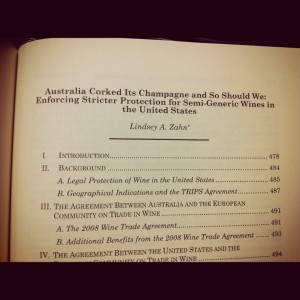This past weekend, I had the pleasure of attending a flag football game on the National Mall here in D.C. We were blessed with some favorable weather on the east coast, allowing me to fully enjoy my spectatorship on the sidelines. In the process, I struck up several conversations with fellow legal scholars, none from which the topic of wine law was absent. One chat in particular paired me with another individual who was familiar with state laws regulating alcohol beverages, and who even wrote a law review article on state laws relating to craft brewers in North Carolina. After our conversation, I started to think fondly about the journey I took some time ago researching my own Note, Australia Corked Its Champagne and So Should We: Enforcing Stricter Protection for Semi-Generic Wines in the United States, covering geographical indications and international wine trade. Perhaps my absolute favorite chapter of my career as a student was researching, drafting, and writing a note exploring the intricacies of the international overtones of wine law and various wine trade agreements. That being said, it is not every day I come across another person who did the same (or similar) during his or her own law school career.
 While the process of note writing is over for me, the journey I pursued three years ago for my Note remains with me on a daily basis in both my legal career and through my blog, On Reserve. The time I spent writing a note directed me to some great student work covering the wine industry, pieces that I took to heart. I felt it appropriate to dedicate an entry to some of the pieces I found most helpful during my research.
While the process of note writing is over for me, the journey I pursued three years ago for my Note remains with me on a daily basis in both my legal career and through my blog, On Reserve. The time I spent writing a note directed me to some great student work covering the wine industry, pieces that I took to heart. I felt it appropriate to dedicate an entry to some of the pieces I found most helpful during my research.- Justin M. Waggoner, Note, Acquiring a European Taste for Geographical Indications, 33 Brooklyn J. Int’l L. 569 (2008). Justin’s piece is probably one of my favorite showcases of student work related to wine law (and my opinion is not based on the fact that his piece was published by my former law journal). His Note is extremely well written and surveys geographical indications (“GIs”) in relation to food products and alcohol beverages. The piece examines the development of GI protection, the applicable TRIPS provisions, a comparison of the types of GI protection sought by the U.S. and the EU, how the U.S. can benefit from implementing a European system, and the steps to improve or change the current framework.
- Mark Silva, Note, Sour Grapes: The Compromising Effect of the United States’ Failure to Protect Foreign Geographic Indications of Wines, 28 B.C. Int’l & Comp. L. Rev. 197 (2005). Mark’s piece suggests that, despite signing the TRIPS Agreement, the United States is not in compliance with the Agreement. Specifically, Mark argues that the U.S. failed to implement legislation that appropriately protects wine and conforms to the requirements of TRIPS. His piece explores many issues and problems that the current environment may bring about for domestic products in the context of international trade and intellectual property.
- Brian Rose, Comment, No More Whining About Geographical Indications: Assessing the 2005 Agreement Between the United States and the European Community on the Trade in Wine, 29 Hous. J. Int’l L. 731 (2007). Brian’s piece provides a very thorough background of the 2005 bilateral wine trade agreement between the United States and the European Community. The comment explores the implications of the trade agreement between the powers as well as the overarching influence of TRIPS.
- Kevin C. Quigley, Uncorking Granholm: Extending the Nondiscrimination Principle to all Interstate Commerce in Wine, 52 B.C.L. Rev. 1871 (2011). This is a great piece that discusses many of the post-Granholm issues our wine industry faces. Opening with a reference to Chief Justice John Marshall’s love for Madeira, Kevin’s work paints a vibrant picture of Granholm, the commerce clause, and the 21st Amendment.